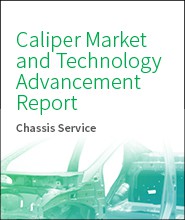
Caliper Market and Technology Advancement Report
Chassis technology is responsible for a vehicle’s overall performance in terms of dynamics, safety, and fuel efficiency—in short, a key contributor to a vehicle’s competitive performance. Furthermore, through the use of advanced materials, it has a significant role to play in reducing carbon dioxide output.
This report looks at the overall global disc brake caliper market covering suppliers and component outlook. The report looks at growth in global disc brake caliper demand. The report also determines the key growth markets, drivers and challenges, and analyses their impact in the near future. It also shares insights on the technology trends related to the global caliper market.
About this report
While vehicles were previously stopped with the help of mechanical drum brakes, higher safety and efficiency standards have dotted today’s automotive sector with disc brakes. Having existed since the early 1900s, today’s disc brakes have come a long way in terms of performance¬¬—stopping distance, handling, and wear—primarily by increasing the number of pistons they carry. The number of pistons in a caliper can range from one to as many as eight, particularly in vehicles with high-power engines or race cars. In fact, motorsport vehicles have significantly driven improvements in brake caliper technology. Without motorsports, such developments would have been delayed.
Roughly 90% of the global caliper market in 2017 consisted of slightly more than 30 suppliers, serving just more than 155 OEMs. Continental, ZF TRW, Akebono, and Mando made up 50% of the global caliper market in 2017, and this is expected to remain unchanged through 2023, although relatively smaller suppliers, such as Brembo, are expected to gain market share as technological advancement drives demand for their products.
On the customer side, the OEM sourcing structure is relatively concentrated, with Toyota, Volkswagen (VW), and Renault-Nissan being the biggest brake caliper clients globally as of 2017, in terms of demand volumes (generated 32% of global demand in 2017). Top OEMs, such as VW, sourced close to USD2.0-billion worth of calipers in 2017, while business generation for a single supplier, such as ZF TRW, went up to just more than USD3 billion. IHS Markit expects OEMs to generate demand worth USD14 billion in 2018 to meet their caliper demand.





